Viewing: Blog Posts Tagged with: JRR Tolkien, Most Recent at Top [Help]
Results 1 - 6 of 6
Blog: Sharon Ledwith: I came. I saw. I wrote. (Login to Add to MyJacketFlap)
JacketFlap tags: Stephen King, Genres, Book Marketing, Rick Riordan, Author Platform, JRR Tolkien, Diana Gabaldon, Author Branding, Sharon Ledwith, Author Taglines, Kelly Armstrong, Reading, Add a tag
Blog: PW -The Beat (Login to Add to MyJacketFlap)
JacketFlap tags: jrr tolkien, Top News, dwarves on mountain goats, hot elves on elks, the hobbit: battle of the five armies, Movies, Add a tag
There is a tower defense game I love to play on the iPad called Kingdom Rush. Not too long ago they released a new version called Kingdom Rush Frontiers which is the most imaginative and adorable version of the game yet. Like all fantasy games, it’s completely tangled up in the vision of JRR Tolkien, with elves, dwarves, rangers and even in this version an ent. Each stage has many extras like little dragons, gnomes, fairies, magic mushrooms and even a game of Simon. It’s adorable and a great way to pass the time.
I found the first Hobbit movie two years ago to be similar to a tub of Cosy Shack rice pudding in that I never got sick of each and every bite, and I just liked watching people named Thorin and Elrond run around. Since then, while I have yet to tire of Cosy Shack, I have tired of Peter Jackson’s Hobbit movies because they are nothing but a map in Kingdom Rsh blown up to IMAX size and length and noise. Maybe it’s just me being 11 years older than when the Return of the King came out, or Peter Jackson being 11 years older, but The Battle of Five Armies seemed to take as much from Jackson’s fanfic King Kong remake as it did the slim book it was based on. And that is not good.
I’m just going to lay down some thoughts here in no particular order. And yeah MASSIVE MASSIVE MASSIVE
s
p
o
i
l
e
r
s
• The opening sequence with Smaug setting fire to Laketown and Bard shooting him down was easily the best sequence in the movie. It also steeled me for disappointment because Bard’s little speech before he uses his last arrow is one of my most favorite parts of the book:
“Arrow! Black arrow! I have saved you to the last. You have never failed me and always I have recovered you. I had you from my father and he from of old. If ever you came from the forges of the true king under the Mountain, go now and speed well!”
Perhaps saying this would have slowed down an intense action sequence, but I really missed it.
• I’ll admit, this movie did stump me as a Tolkien scholar. When, just before the big battle kicks off about 45 minutes from the end, the orcs employ giant sandworms called were worms that recall nothing so much as the lampreys that took up about three hours of the 8 hour King Kong…I thought “THIS GOES TOO FAR!!!!” But lo and behold, while I knew about stone giants, Queen Beruthiel and the Variags of Khand, I happened to miss the one sentence in the VERY FIRST chapter of the Hobbit that mentioned were-worms:
“Tell me what you want done, and I will try it, if I have to walk from here to the East of East and fight the wild Were-worms in the Last Desert.”
That’s what Bilbo says. It’s clearly a reference to a more primitive fairy tale version of Middle Earth that Tolkien explored in The Hobbit. So you get a pass there, Peter Jackson….but JUST BARELY.
• Similarly, Thranduil, king of the Sylan elves of Mirkwood rides an Elk into battle. This struck me as…well it looked awesome. And it seemed sort of Tolkienish. But then Radagast has a bunny sled, Dain rides a boar and in the middle of the BoFA, suddenly out of nowhere some ridable mountain goats appear to enable Thorin, Kili, Fili and Balin to go hopping up a mountain. I understand that the mountain goat steeds were introduced in a longer cut of theemovie—Warner Bros insisted Jackson deliver a brisk 2:20 cut of the film and a LOT of stuff was left out. I think if I’m sitting in a movie theater for two hours and 20 minutes of cgi action I’ll take another 10 minutes to explain where dwarves got mountain goats to ride but then…I don’t run a studio. Anyway, one cute animal steed I could take, but three whole movies of them???
• AND YET THEY COULDN’T SHOW BEORN FOR MORE THAN 10 SECONDS???? WHAT IS WRONG WITH YOU PEOPLE.
• All that said, Lee Pace as Thranduil astride an elk…OMG. Thranduil was the best thing in the last two movies. He has the only truly funny moment in the whole Battle of Five Armies—I won’t spoil it for you because it is so so precious—and despite being effete and aloof is a total badass in battle.
• Am I the only one who thinks that Thranduil and the only female on screen maybe hooked up after Legolas is sent off to find Strider? Thranduil is a lonely elf who has lost love and now so is Tauriel. The age difference doesn’t matter because ELVES ARE IMMORTAL. If I were Tauriel I would totally go for it.
• Ever since I heard about these films and how the Hobbit was going to be three movies, I was all set up for the scene where the White Council kicks Sauron out of Dol Guldur. Maybe I just built it up in my mind too much because in the movie it seemed like an after thought. Yes we got to see Battle Action Galadriel and Battle Action Saruman and Battle Action Elrond, but…this should have been the ultimate Boss battle and it was…eh.
• ALSO…9 figures of CGI and you couldn’t make it look like Cate Blanchett was not carrying a dummy?
• Battle of Five Armies carries over one of Jackson’s WORST habits from King Kong: The Subplot Character Who Goes Nowhere. In King Kong it was Tintin, I mean Billy Elliott, I mean Jimmy, who has many long conversation with the ship’s captain about responsibility and duty and something, and you think it’s going somewhere and….it was a lot of wasted time. In BoFA that character is Alfrid, the two-faced assistant to the Master of Lake Town. At first Alfrid is just a slimy Wormtongue like character. But when he attaches himself to Bard after the death of Smaug, we see Bard begin to trust him a little, despite Alfrid being completely inept at everything he tries. At the end of the battle, Alfrid absconds in drag with all the gold he can stuff into his bra. REALLY. Was he merely there for comic relief the whole time? Or did he have an actual story arc? Also, he had really weird shoulders, and at first I just thought he idolized Linda Evans in Dynasty and favored shoulder pads. Then I realized that he was supposed to be a hunchback—yes it’s the deformed, slimy weasel thief trope. I think Alfrid was just around to throw in some comedy and keep the dwarves in battle mode, but it was positively Jar Jar esque.
• The actual main action of the film, such as it is, involves Thorin’s falling prey to the gold lust of the dragon, and how it ultimately destroys him and nearly Dale and Erebor and the free peoples as well. I thought Richard Armitage did a fine job of showing the evolution of the character, even if turning evil only meant wearing a black fur coat for a while (he liked Joan Collins in Dynasty?) Once he throws off the coat, he turns back to his regular self. As you do.
• Bilbo’s story arc is mostly from the book, with his giving the Arkenstone to Thranduil and Bard so they can make Thorin keep his part of the bargain and avoid war. When I was a kid and read The Hobbit this whole part of the book annoyed me greatly. WHY WAS EVERYONE BEING SUCH A DICK??? They killed the dragon, can’t they just have a party and be friends? As an adult, this was more satisfying and realistic
• If you had told me that there would someday be a movie version of Mt. Gundabad, I would have been so excited. But then it is thrown in just so Legolas and Tauriel can go off and…spend some quality spying time together. WHY. The actual amount of the book that this movie adapts is only three or four chapters so they had to throw in all kinds of extra action.
• If you read the book, you knew that Thorin, Kili and Fili, the three most loveable dwarves, are all doomed to die. In the book, they just die in the general battle. Because this is a movie and plotlines must be ended they first have to go to Ravenhill where Azog is flying kites and tooting horns. Legolas and Tauriel must get there because they have to warn Thorin that another army of orcs is coming! Seeing as how HE WAS ALREADY SURROUNDED BY AN ARMY OF ORCS. Ravenhill does appear in the books, but a short trip to my bookshelf to retrieve my childhood copy of The Hobbit reveals that IT IS NOT ACTUALLY ON THE MAP IN THE BOOK AS IT IS IN THE MOVIE MAP. Not that it all has to be like the book, but in the LoTR trilogy when they threw in extra stuff my heart soared with joy at seeing things I had only imagined being acted out on a giant screen. In general in the Hobbit the additions are all to make a giant, bloated movie that will make a lot of money. (I did like the call back to the Battle of Azanulbizar in part one.) Ravenhill is one of the worst examples of that. “Say how can we get all the main characters separated from the fray?” “What about that Ravenhill thing?” “Great idea!” Once on this remote locale, Legolas, Tauriel, Azog, Bolg, Thorin, Kili, Bilbo and anyone else who had a story arc run around and have tumultuous fights. This also leads to the ONE truly creepy and memorable shot in the whole film when Thorin and Azog are having it out. I won’t spoil it!
• I did not hate all the Hobbit movies as the above may indicate. The problem is that with the Lord of the Rings films I had years to think it was going to suck and then they turned out to be better than I had ever dared dream. With The Hobbit I had year to think it was going to be great and…it wasn’t.
• That said, when they announce the inevitable three pack of extended editions, I will pre-order it lickety split.
Blog: PW -The Beat (Login to Add to MyJacketFlap)
JacketFlap tags: History, james bond, Culture, olympics, jk rowling, jrr tolkien, danny boyle, arthurian legends, glastonbury, industrialization, czech rubber boots, isumbard kingdom brunel, noel fielding, opening ceremont, the white goddess, voldemort vs poppins, Add a tag
Friday’s Olympic Opening Ceremony was perhaps the most deliriously audacious live spectacle of the Internet age. Devised by the Anglo-Irish Danny Boyle, it celebrated the uniquely English heritage of industrialization, socialized medicine, drug-inspired music trends, James Bond and fantasy literature. God, how did I even write that sentence? Anyway, it was a night of both triumph and tragedy for nerds—while the geek-friendly moments of the ceremony were copious and unashamed, there was still Twitter outrage over a rumored appearance by Doctor Who somehow being cut for time. As I tweeted at the time, this was somehow nerd privilege overrun. As some anxiously pointed out, there was a “Doctor Who Tardis sound” at the end of the pop music/social media segment, but that was not quite enough to drown out the other supremely nerd-centric moments that were viewed by a billion people worldwide:
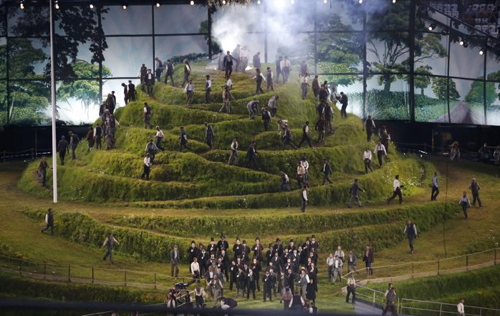
Glastonbury Tor is a place renowned in Christian and pagan mythology and figures prominently in both Celtic and Arthurian lore. Its central place in the Olympic festivities gives it an even more modern allusions. The sacred tree around which the national flags are planted goes back to pagan tree lore. Go read The White Goddess if you need any more explanation.
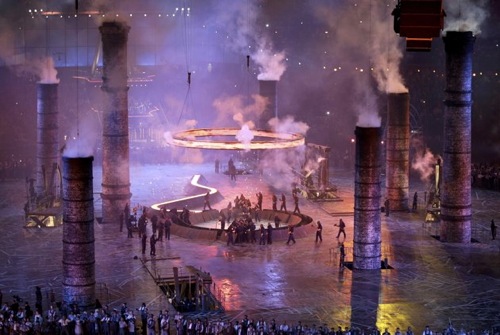
The whole forging of the ring sequence — surrounded by belching smokestack towers — was overtly Tolkienian, even if it didn’t directly reference the professor. It echoes the “Scouring of Shire” chapter of Lord of the Rings—Tolkien’s own allegory of the destruction of agrarian Britain by the advent of industrialization— while the visuals seem to reference Peter Jackson’s take on Isengard. I would say there is also some Wagnerian/Norse Das Rheingold in there, but best not to bring up Germanic lore here.
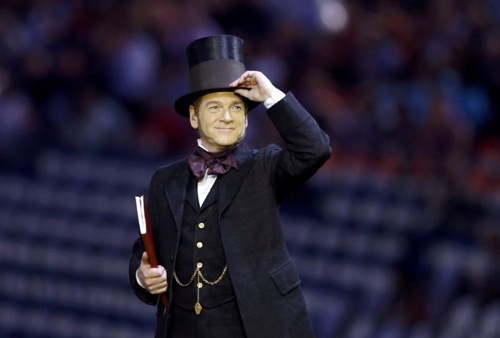
Kenneth Brannagh appeared as Isambard Kingdom Brunel, a cigar chomping engineer and architect, who designed railway grades and bridges. While he lived before the internet, Brunel seems the kind of guy who would today play D&D as an undergrad; he also designed the “train shed” where the Bristol Comic-Con is held.
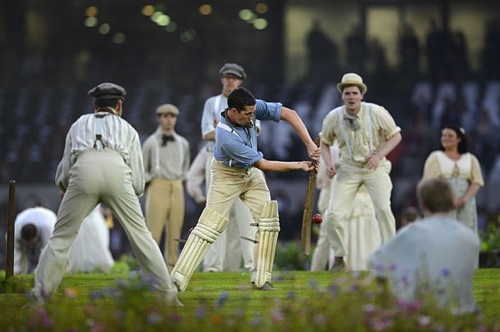
Blog: Dystel & Goderich Literary Management (Login to Add to MyJacketFlap)
JacketFlap tags: reading, fun, favorites, adolescence, Jessica, New Yorker, JRR Tolkien, Ayn Rand, Add a tag
But I wonder what made it on to your unofficial list of adolescence? Did you read Rand? And what do Howard Roark and Bilbo Baggins have in common? Also, if anyone can tell me what article I’m paraphrasing, I’d be grateful.
Blog: OUPblog (Login to Add to MyJacketFlap)
JacketFlap tags: Literature, Reference, UK, A-Featured, Lexicography, Tolkien, oxford english dictionary, Prose, hobbit, JRR Tolkien, blotmath, winterfilth, Add a tag
J.R.R. Tolkien’s first job was as an assistant on the staff of the OED, and he later said that he had ‘learned more in those two years than in any other equal period of [his] life.’ In The Ring of Words: Tolkien and the Oxford English Dictionary, three senior OED editors – Peter Gilliver, Jeremy Marshall, and Edmund Weiner – explore more than 100 words found in Tolkien’s fiction, such as ‘hobbit’, ‘attercop’, and ‘precious’. Edmund Weiner has written this original post for OUPblog on Winterfilth (October) and Blotmath (November).
As I write this blog Winterfilth is coming to an end and Blotmath is about to begin. What on earth am I talking about? Well, as the Tolkien enthusiasts out there will know, these are the names that the hobbits used for October and November.
 As it happens, although the action of The Lord of the Rings spans October and November (avid readers will remember that a lot of action happens in the one and the other is spent by the hobbits resting in Rivendell), these month names are not used in the story. They are given in an appendix in which Tolkien explains the calendar of the Shire (the land of the hobbits) and the hobbits’ names for the days of the week and the months.
As it happens, although the action of The Lord of the Rings spans October and November (avid readers will remember that a lot of action happens in the one and the other is spent by the hobbits resting in Rivendell), these month names are not used in the story. They are given in an appendix in which Tolkien explains the calendar of the Shire (the land of the hobbits) and the hobbits’ names for the days of the week and the months.
Did Tolkien make these names up? No. Some people will be surprised to learn that he made up none of his ‘English’ words, as opposed to the words of the elvish, dwarvish, and orkish languages. (The one exception, funnily enough, may be the word ‘hobbit’—but the jury on that is still out.) The other strange and archaic-looking words, such as mathom, Arkenstone, eleventy, flet, and barrow-wight, are all based on earlier usage and generally go back either to Anglo-Saxon (Old English, English before the Norman Conquest) or to Old Norse (the language of the Vikings and Sagas).
So what about the months? Tolkien borrowed them for the hobbits from Anglo-Saxon texts that give both the Latin names of the months (the names we use now) and their Old English equivalents. None of the latter seem to have survived the Conquest except (in a different meaning) Yule, and Lide, a now obsolete dialect word for March, which may have meant ‘loud’ (referring to its windiness). Blotmath, or rather Blotmonath or Blodmonath, was the time when in pagan times cattle were sacrificed (blotan ‘sacrifice’ or blod ‘blood’).
And Winterfilth? In Old English this was Winterfylleth, in which fylleth means ‘fulness’, or perhaps ‘full moon’. The word for ‘filth’ was spelt and pronounced differently, but in modern English they would have come to sound the same, and this gave Tolkien an opportunity for one of the scholarly etymological puns to which he was very partial.
Blog: OUPblog (Login to Add to MyJacketFlap)
JacketFlap tags: A-Featured, Lexicography, Dictionaries, oed, Podictionary, hobbit, Charles Hodgson, JRR Tolkien, Add a tag
iTunes users can subscribe to this podcast ![]()
A lot of the dictionaries I looked at don’t even include the word hobbit.
Most of the ones that do credit JRR Tolkien as having dreamt up hobbits for his books The Hobbit and Lord of the Rings.
This is both understandable and believable.
 But when I looked at Brewers Dictionary of Modern Phrase and Fable I got a hint of something more. While most of the other sources say that hobbits were created by Tolkien, Brewers slyly says that they feature in his stories.
But when I looked at Brewers Dictionary of Modern Phrase and Fable I got a hint of something more. While most of the other sources say that hobbits were created by Tolkien, Brewers slyly says that they feature in his stories.
To get the deeper truth we need to burrow deeper into the hobbit hole and The Oxford English Dictionary is the place to do that.
The OED is in a unique position of authority because Tolkien actually worked there for a few years early in his career. Plus a later editor had studied under Tolkien’s professorship.
So in the late ‘60s when The Lord of the Rings was making its first rise to popularity the OED added hobbit as an entry.
How better to check out the etymology of the word than to ask its creator?
Except that JRR Tolkien denied having created the word.
He helped them define it as an imaginary people, small but human, whose name means ‘hole-dweller’ but did not claim credit for their invention.
No citations were found that predated Tolkien’s 1937 use in the book of the same name, so that’s what’s given as hobbit’s earliest usage in OED.
But since that time, as reported in an OED newsletter, the word has been found in a 19th century folklore journal.
So even though JRR couldn’t remember where he’d first heard of hobbits, it turns out his denial of inventing them was justified.
Five days a week Charles Hodgson produces Podictionary – the podcast for word lovers, Thursday episodes here at OUPblog. He’s also the author of several books including his latest History of Wine Words - An Intoxicating Dictionary of Etymology from the Vineyard, Glass, and Bottle.






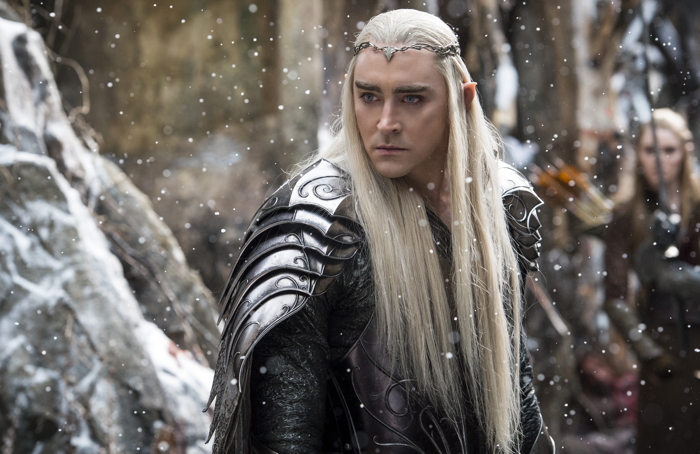
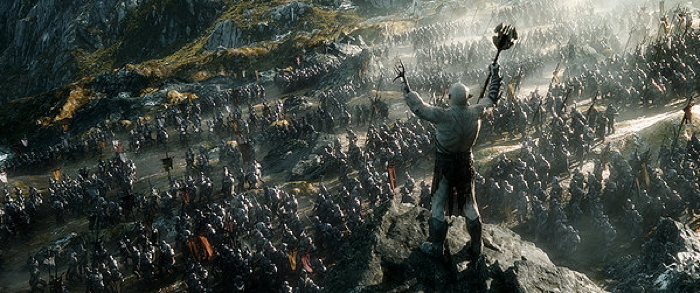

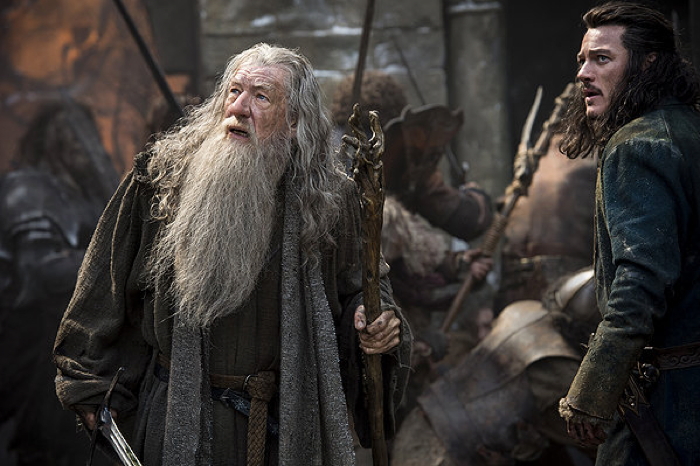

I’m waiting for someone to edit the three parts into one two-hour movie.
That said, how does this compare to the Rankin/Bass version?
Have my tickets, can’t wait to go watch and go read this and other reviews.
I must see the Rankin-bass version again to hear Bard’s speech again
Heidi, have you seen BIRDMAN? I’d like to to read your take on that … even though it’s not the sort of franchise movie that fanboys and fangirls crave.